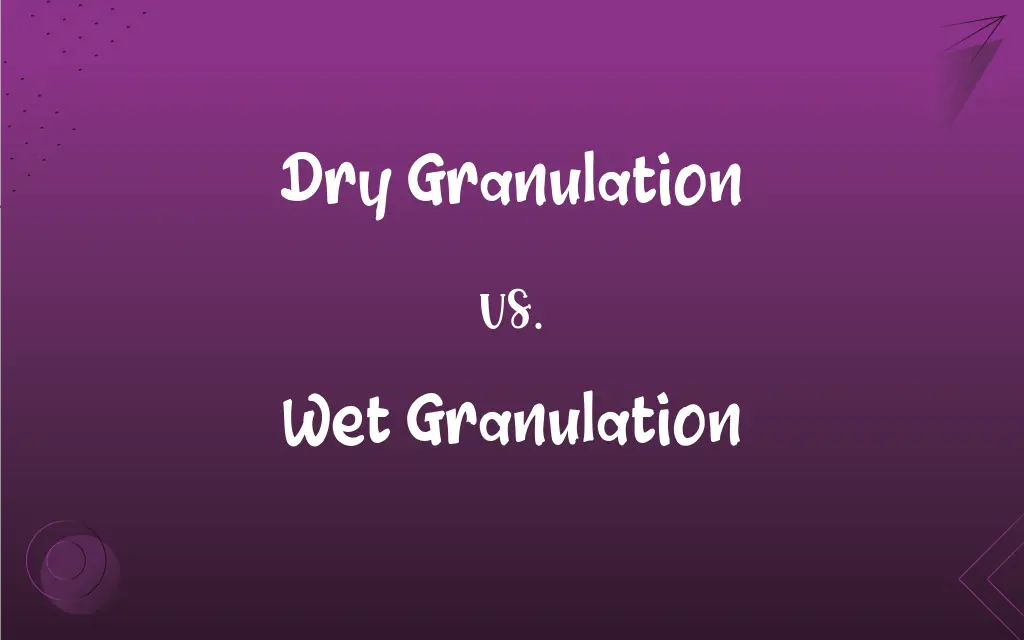Dry Granulation vs. Wet Granulation: What's the Difference?
Edited by Harlon Moss || By Janet White || Published on July 13, 2024
Dry granulation compacts powder into granules without liquids; wet granulation binds powder with a liquid binder.

Key Differences
Dry granulation is a process where powder particles are compacted by external forces without the use of a liquid binder, typically involving steps such as slugging or roller compaction. The compacted material is then milled into granules. This method is suitable for materials sensitive to moisture or heat. Wet granulation, on the other hand, involves the addition of a liquid binder to the powder mixture to form agglomerates. The wet mass is then dried and milled into granules. This technique improves the flowability, compressibility, and uniformity of powder blends for tablet manufacturing.
Dry granulation is favored for materials that are moisture-sensitive or have a high melting point, making it an ideal choice for certain pharmaceutical and food products. It is also considered more energy-efficient since it avoids the drying step. Wet granulation is preferred when the powder mixture requires enhanced binding or when the final product needs to have a specific dissolution rate, which can be effectively controlled through the wet granulation process.
The equipment used in dry granulation, such as roller compactors and slugging machines, is generally simpler and easier to clean, leading to lower production costs and faster processing times. Wet granulation requires more complex equipment, including mixers, granulators, and drying ovens, which can increase production time and costs. However, wet granulation offers better control over the granule size and uniformity, which can be crucial for certain applications.
Dry granulation can result in granules with higher density but potentially less uniformity in size and shape compared to those produced by wet granulation. Wet granulation produces more spherical, uniform granules, which can lead to better tablet uniformity and dissolution properties. However, the process can introduce moisture and heat, which may degrade sensitive active ingredients.
Dry granulation is considered more environmentally friendly due to the absence of liquid waste and the reduced need for energy-intensive drying processes. Wet granulation, while requiring more energy and generating wastewater, allows for the production of granules with specific properties that can be tailored to meet stringent product specifications.
ADVERTISEMENT
Comparison Chart
Binder Use
Does not use a liquid binder.
Uses a liquid binder to form granules.
Equipment
Utilizes slugging or roller compaction.
Requires mixers, granulators, and dryers.
Material Sensitivity
Suitable for moisture-sensitive materials.
Not suitable for heat-sensitive materials.
Energy Efficiency
More energy-efficient due to no drying step.
Less energy-efficient due to drying requirement.
Granule Characteristics
Produces denser, less uniform granules.
Produces more uniform, spherical granules.
ADVERTISEMENT
Dry Granulation and Wet Granulation Definitions
Dry Granulation
A process of forming granules without using a liquid.
The pharmaceutical company used dry granulation for the moisture-sensitive drug.
Wet Granulation
Can modify drug release characteristics.
Adjusting the wet granulation parameters fine-tuned the medication's release rate.
Dry Granulation
Involves compaction and milling of powder.
Compacting the powder through dry granulation enhanced its flow properties.
Wet Granulation
Involves mixing, granulating, and drying steps.
The granulator mixed the powder and binder in the wet granulation process.
Dry Granulation
Produces granules by mechanical means.
The roller compactor efficiently produced granules via dry granulation.
Wet Granulation
Requires drying to remove moisture.
The drying phase in wet granulation removed excess moisture from the granules.
Dry Granulation
Suitable for materials that react with moisture.
Dry granulation was chosen due to the ingredient's moisture sensitivity.
Wet Granulation
Enhances the compressibility of powder blends.
Wet granulation was used to ensure the powder's compressibility for tablet pressing.
Dry Granulation
A method that avoids the drying process.
The absence of drying in dry granulation saved significant energy costs.
Wet Granulation
A process using a liquid binder to form granules.
Wet granulation improved the tablet's dissolution rate by enhancing granule uniformity.
FAQs
What are the main advantages of dry granulation?
The main advantages include no need for drying, reduced manufacturing time, and suitability for moisture-sensitive materials.
What is dry granulation?
Dry granulation is a process used in the pharmaceutical and related industries to form granules without using a liquid solution, as the product may be sensitive to moisture and heat.
How does dry granulation work?
It involves compacting and then milling the powder blend to form granules, typically using a roller compactor or a slugging (tablet press) method.
What are common applications of dry granulation?
Common applications include tablet manufacturing for pharmaceuticals, especially for moisture-sensitive drugs.
Can dry granulation affect the dissolution rate of a product?
Yes, it can potentially decrease the dissolution rate due to denser, less porous granules compared to those produced by wet granulation.
How does wet granulation work?
The process involves mixing a powder blend with a binder solution, granulating the wet mass, and then drying the granules to remove moisture.
What equipment is used in dry granulation?
The primary equipment includes a roller compactor and a mill for size reduction.
Is dry granulation scalable?
Yes, dry granulation is scalable, but it requires careful consideration of process parameters to maintain product quality.
When is dry granulation preferred?
It's preferred for materials that are sensitive to moisture or heat, which can degrade the product during wet granulation.
What is wet granulation?
Wet granulation involves adding a liquid binder to a powder blend to form granules, followed by drying.
Are there any disadvantages to dry granulation?
Disadvantages may include more limited particle size distribution control and potential for lower product homogeneity compared to wet granulation.
How is the quality of dry granulated products tested?
Quality is assessed through tests for compactibility, flowability, and compressibility of the granules.
What equipment is used in wet granulation?
Key equipment includes a high-shear mixer/granulator, fluid bed dryer, or a tray dryer for drying the granules.
Can wet granulation affect the dissolution rate of a product?
Yes, it can improve the dissolution rate due to the increased porosity and surface area of the granules.
Are there any disadvantages to wet granulation?
Disadvantages include the potential for degradation of heat or moisture-sensitive materials and the need for drying, which adds time and cost.
What are the main advantages of wet granulation?
Advantages include improved powder flowability, better compression characteristics, and enhanced homogeneity.
Is wet granulation scalable?
Wet granulation is scalable, but scaling up requires careful control of process parameters to ensure product consistency.
When is wet granulation preferred?
It's preferred when the drug mixture requires enhanced binding and cohesion to form tablets or capsules.
What are common applications of wet granulation?
It's widely used in pharmaceuticals for tablet and capsule manufacturing, especially when the drug blend needs improved binding.
How is the quality of wet granulated products tested?
Quality tests include moisture content, granule size distribution, compressibility, and flow properties.
About Author
Written by
Janet WhiteJanet White has been an esteemed writer and blogger for Difference Wiki. Holding a Master's degree in Science and Medical Journalism from the prestigious Boston University, she has consistently demonstrated her expertise and passion for her field. When she's not immersed in her work, Janet relishes her time exercising, delving into a good book, and cherishing moments with friends and family.
Edited by
Harlon MossHarlon is a seasoned quality moderator and accomplished content writer for Difference Wiki. An alumnus of the prestigious University of California, he earned his degree in Computer Science. Leveraging his academic background, Harlon brings a meticulous and informed perspective to his work, ensuring content accuracy and excellence.








































































